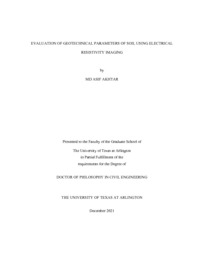| dc.description.abstract | Electric resistivity imaging (ERI) is an effective non-destructive and rapid measuring way of obtaining continuous soil subsurface resistivity profiles. An ERI technique can be used to identify moisture variations and soil heterogeneities in an area. Thus, ERI is becoming a popular tool in geotechnical (FHWA, 2015)engineering; however, it only provides qualitative information at the current time. Using qualitative images, it is challenging to extract quantitative geotechnical information, such as the type of soil, moisture content, degree of saturation, and atterberg limit, of the subsurface. Several studies have described the electrical resistance of soil as a function of pore fluid conductivity and surface conductance. Additionally, electrical resistivity measurements have also been made on commercial soils in order to determine the influence of geotechnical properties. Since a conventional geotechnical investigation may not perform characterization tests of pore water or surface charge, electrical resistivity must be correlated with geotechnical properties that can be tested in the laboratory. The objective of this experimental study is to investigate the relationship between the electrical properties of soil and geotechnical parameters of locally available soil and determine correlations between geotechnical parameters and electrical resistivity that can be used by geotechnical engineers.
A study was conducted to study the electrical properties of soils obtained from 22 boreholes of four different locations, namely Fort-Worth, Beaumont, Corpus Christi, and El-Paso, selected based on their geological formation. Besides collecting soil samples through soil borings using the Texas Cone Penetration (TCP) method, a field, electrical resistivity survey was also conducted using 28 and 56 electrodes at the same locations to obtain a subsurface resistivity map. Field resistivity values were correlated with soil TCP values, and the correlation was compared to previous literature. In this study, 44 soil samples classified as low plastic clay (CL), 15 samples as high plastic clay (CH), and four samples as elastic silt (MH) were used to measure the resistivity of compacted clay soils. Furthermore, soil samples were categorized into six categories based on their liquid limit higher than 50, between 35 and 50, and lower than 35, and plastic limit higher than 25 and lower than 25 to investigate the changes in geoelectrical properties of soil. Various geotechnical conditions were used in laboratory tests to determine the influence of soil parameters on electrical resistivity. In both clayey soils and sandy soils, electrical resistivity measurements were found strongly influenced by the moisture content and degree of saturation. Soil resistivity was found to be averagely decreased by 80%, 43%, and 21% of initial value when the soil moisture content was increased from 10% to 20%, 20% to 30%, and 30% to 40% except for the soil samples contains liquid limit less than 50 and plasticity index higher than 25 for unit weight of 11.8 KN/m3. Soil resistivity was found to be decreased by 42%, 25%, and 41% for the above-mentioned water content due to the high activity of soil. Moreover, soil resistivity decreases 45% and 49% of the initial values when the unit weight increases from 11.8 KN/m3 to 13.4 KN/m3 and 13.4 KN/m3 to 14.9 KN/m3. Soil resistivity decreases as much as 57-fold for normal clay and 7.5 fold for active clay from the initial value when the degree of saturation increased from 17% to 100%. However, the rate of change of resistivity is low when the degree of saturation of compacted clay is more than 50%. Furthermore, clay properties such as liquid limit and plasticity index also affect electrical resistance at different saturation levels. However, at a higher level of saturation, geotechnical parameters have less impact on electrical resistivity.
The soil engineering properties of both sandy and clayey soils were correlated with electrical resistance using different multiple linear regression (MLR) models developed with R-studio. In developing a multiple linear regression equation for clayey soil, the degree of saturation and plasticity index were selected as independent parameters, while for sandy soil, moisture and sand content were used. Validation of the MLR models was based on field data, and therefore these models can be used for estimating engineering properties. | |


